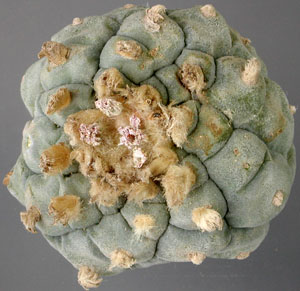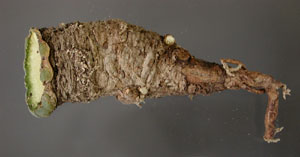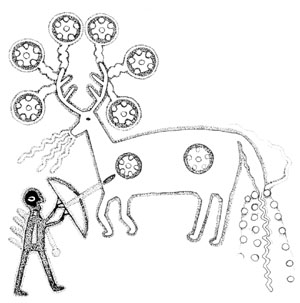Peyote
Lophophora williamsii (Lem.) Coult.
Cactaceae (Cactus Family)
Peyote is a small spineless cactus with a flattened, globose, blue-green stem divided by five to 13 (very rarely four or 14 ) ribs that are often tuberculate. The adult cactus measures 4-11 cm in diameter but only 2-6 cm tall. It features small areoles arranged along the ribs and bearing soft whitish hairs. The subterranean portion of the stem, which is as wide as the aerial portion, extends several cm below the surface of the ground and transitions smoothly (through a thin hypocotyl) into a large taproot (Terry and Mauseth 2006), which may extend over 25 cm below ground level.
Peyote grows in an area that stretches from from the Chihuahuan Desert to the South Texas Plains, on either side of the middle and lower Rio Grande River, southward to the Mexican state of San Luís Potosí. Extensive stands of peyote occur on the low, rocky hills in Starr, Zapata, Webb, and Jim Hogg counties of southern Texas.
One striking characteristic of peyote is its alkaloid content; a recently dried peyote button contains about 8% alkaloids of which 2.4% is mescaline, (Bruhn and Holmstead 1974) which has conventionally been classified as a hallucinogen (Drug Enforcement Administration 2006) . However, the actual effects of peyote ingestion are comparatively mild; one doesn't lose consciousness, nor do extreme hallucinations occur, but rather one experiences vivid colors, tactile sensitivity, and altered attitudes or emotional states, usually euphoria (Anderson 1996). The initial effect after consumption is often nausea followed by a euphoric, thoughtful, or meditative stage. Summed up, peyote produces an altered state of consciousness.
Archeology. Peyote has long been recognized by Native Americans as both a medicinal plant and a powerful sacrament. Historic references imply that there is a very long history of peyote use, however, the archeological record is scant. This is understandable, since peyote was a sacred object, you won't find it in trash heaps (middens), or in house floors, the archeologist's most productive source of information. Peyote would only be recovered from ritual contexts, such as special structures, or from graves. In fact, W.W. Taylor excavated nine peyote crowns strung together on a cord in a burial cave in the Cuatro Ciénegas basin of Coahuila, Mexico (Taylor 1988). One of these specimens was recently radiocarbon dated to 835+35 radiocarbon years ago, or a 2s calendar date of 1070-1280 AD (Terry et al. 2006).
Specimens shaped like the body of peyote were excavated in the 1930s from Shumla Cave in the Lower Pecos region of southwestern Texas. These specimens, are not actually desiccated crowns of peyote, but are aggregates of ground peyote mixed with other plant material. They form flattened globular objects resembling peyote buttons. Two of the Shumla Cave specimens have been analyzed, indicating a 2% concentration of mescaline, the psychoactive alkaloid in peyote (Bruhn et al. 2002; El Seedi et al. 2005). These specimens recently have been radiocarbon dated to 4045-3960 B.C. (2s) (Terry et al. 2006). Other links to prehistory include parallels between the 4,000 year-old pictographs of the Lower Pecos and Huichol art and peyote ritual have been described by archeologists (Boyd 1996; 2003; Boyd and Dering 1996). Bottom line is that interactions between people and peyote have a deep history extending back thousands of years.
History and Ritual Use. To many Native Americans peyote is a sacred power plant and a sacrament. Peyotism north of the Rio Grande probably originated in northern Mexico and southern Texas along the Rio Grande (Hultkrantz 1997; La Barre 1975; Stewart 1974;1987), near the northern limits of the natural distribution of peyote. Its use by Native Americans was first documented in Mexico in AD 1560 by Fray Bernardo Sahagún, who referred to the péyotl root. From pre-Conquest time to the early nineteenth century, various groups located in Mexico and Texas utilized peyote cactus. These groups include the Aztec, Zacateco, Tarascan, Cazcan, Guachichil, Huichol, Lagunero, Tepehuan, Tepecano, Cora, Acaxee, Tamaulipeco, Coahuilteco, Tarahumara, Opata, Akmiel O'odham (Pima), Tohono O'odham (Papago), Yaqui, Jumano, Julimeno, Lipan Apache, Carrizo, Tonkawa, Karankawa, Mescalero Apache, Caddo, Otomi, and Tlascalan (Hrdlickla 1908; Shonle 1925; Stewart 1987).
The use of peyote has long extended far beyond its natural distribution. In the nineteenth century, peyote use spread northward to Oklahoma where the modern peyote religion of the Native American Church became formalized during the 1880s (Hultkrantz 1997; Stewart 1987). During 20th century various Indian groups such as Comanches and Kiowas and tribes from Oklahoma journeyed to the lower Pecos region and southern Texas to harvest peyote for ceremonial use. The Comanches and the Kiowas reportedly collected peyote along the Rio Grande and Pecos River (Slotkin 1951, 1955; Stewart 1987). According to Jack Skiles, a botanist living in the area of Langtry, Texas, "Indians from Oklahoma made trips to Langtry for many years (during the 1930s) gathering peyote for use in their religious ceremonies" (Skiles, cited in Stewart 1987). Today the major collecting areas are located further down the Rio Grande in the South Texas Plains.
The art of the Huichol Indians of Nayarit and Jalisco reflects the importance of peyote ritual in their culture. Detailed descriptions of the peyote ceremony abound for this group. Interestingly, the Huichol make repeated pilgrimages to their sacred homeland, Wirikúta, in the Mexican state of San Luis Potosi, to collect the plant. They call Wirikúta their homeland but state that they come from even further north, and that area is in the state of Coahuila, just south of the Rio Grande from the Lower Pecos and South Texas Plains regions.
Medicinal Applications. Dozens of medicinal applications have been attributed to peyote. Taken in small doses, peyote is a mild stimulant and reduces appetite. The medical uses of peyote rest on a fairly sound biochemical foundation. Peyote contains peyocactin, a water soluble, crystalline substance that possesses antiseptic/antibiotic properties against many types of bacteria. Another constituent of peyote, hordenine, inhibits the growth of several strains of Staphylococcus bacteria that are otherwise resistant to penicillin. Small wonder that peyote was consumed or applied in small doses for a variety of cures. The Tarahumara applied masticated peyote to bites, burns, wounds, and aching muscles. Tarahumara runners chewed fragments of buttons during their epic foot races, which usually spanned long distances from village to village, often exceeding 50 miles. The peyote strengthened them and kept evil forces at bay (Bye 1979; Lumholtz 1902). It was also used as a topical application to treat fractures (Pennington 1963), and Tepehuan distance runners rubbed peyote salve on their legs to strengthen them for the race (Pennington 1969). The Kiowa used peyote for treating the flu, scarlet fever, tuberculosis, and venereal disease (Vestal and Schultes 1939: 43).
(This entry benefited from gracious comments and technical assistance by Dr. Martin Terry, Sul Ross State University, Alpine, Texas.)
References
Anderson, Edward F.
1996 Peyote: The Divine Cactus. 2nd ed. University of Arizona Press, Tucson.
Boyd, Carolyn E.
1996 Shamanic Journeys into the Otherworld of the Archaic Chichimec. Latin American Antiquity 7(2):152-164.
2003 The Rock Art of the Lower Pecos. Texas A&M University Press. College Station, Texas.
Boyd, Carolyn E. and J. Philip Dering
1996 Medicinal and Hallucinogenic Plants Identified in the Sediments and the Pictographs of the Lower Pecos, Texas Archaic. Antiquity 70(268):256- 275.
Bruhn, Jan G. and Bo Holmstedt
1974 Early Peyote Research -- an Interdisciplinary Study. Economic Botany 28:353-390.
Bruhn, Jan G., Peter A.G.M. De Smet, Hersham R. El-Seedi, Olof Beck
2002 Mescaline Use for 5700 Years. Lancet 359:1866.
Bye, Robert A.
1979 Hallucinogenic Plants of the Tarahumara. Journal of Ethnopharmacology 1:23-48.
Drug Enforcement Administration
2006 Hallucinogenic substances. 21 CFR §1308.11(d)
El-Seedi, Hehsam, Peter A.G.M. De Smet, Olof Beck, Goran Possnert, Jan G. Bruhn
2005 Prehistoric Peyote Use: Alkaloid Analysis and Radiocarbon Dating Of Archaeological Specimens of Lophophora From Texas. Journal of Ethnopharmacology 101:238-242.
Hrdlicka, Ales
1908 Physical and Medical Observations Among the Indians of Southwestern United States and Northern Mexico. Bureau of American Ethnology. Bulletin 34. Smithsonian Institution. Government Printing Office, Washington D. C.
Hultkrantz, Ake
1997 The Attraction of Peyote: An Inquiry into the Basic Conditions for the Diffusion of the Peyote Religion of North America. Almqvist and Wiksell International, Stockholm, Sweden.
Lumholtz, Carl
1902 Unknown Mexico II. II vols. Scribner, New York.
Pennington, Campbell M.
1963 The Tarahumara of Mexico: Their Environment and Material Culture. University of Utah Press, Salt Lake City.
1969 The Tepehuan of Chihuahua: Their Material Culture. University of Utah Press. Salt Lake City.
Shonle, Ruth
1925 Peyote: The Giver of Visions. American Anthropologist 27:53-75.
Stewart, Omer C.
1987 Peyote Religion. University of Oklahoma Press, Norman.
Terry, Martin, Karen Steelman, Tom Guilderson, Phil Dering, and Marvin Rowe
2006 Lower Pecos and Coahuila Peyote: New Radiocarbon Dates. Journal of Archaeological Science 33:1017-1021.
Terry, Martin and James D. Mauseth
2006 Root-shoot anatomy and post-harvest vegetative clonal development in Lophophora williamsii (Cactaceae: Cacteae): implications for conservation. Sida, Contributions to Botany 22: 565-592.
Vestal, Paul A. and Richard Evans Schultes
1939 The Economic Botany of the Kiowa Indians. Cambridge MA. Botanical Museum of Harvard University (p. 43)


